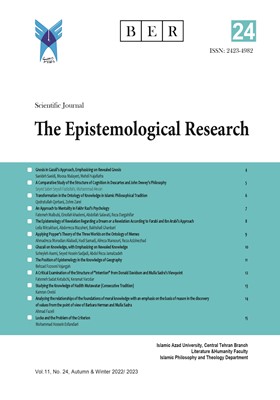Applying Popper's Theory of the Three Worlds on the Ontology of Memes
Subject Areas : Epistemological researchesAhmad reza Moradian Ali abadi 1 , Hadi Samadi 2 * , Alireza Mansouri 3 , reza Azizinezhad 4
1 - . Ph. D. Candidate of Philosophy, Islamic Azad University, Science and Research Branch of Tehran
2 - Assistant Professor, Islamic Azad University, Science and Research Branch of Tehran,
3 - The Head of Philosophy of Science Dept. IHCS,
4 - Assistant Professor, Department of Biotechnology, Faculty of Agricultural Sciences and Food Industry, Science and Research Unit, Islamic Azad University, Tehran, Iran,
Keywords: Ontology, the Meme, Three World Theory, Karl Popper,
Abstract :
There are different opinions regarding the origin of Memes’ ontology. Some researchers, including Blackmore and Dennett, believe that Memes are cultural creatures, while others, including Lynch and Bridie, recognize them as intellectual entities. Moreover, some researchers, including Gatherer and Benzon, consider the Memes as physical existence. Some critics such as Boyd and Riechrson, and their supporters, deny the existence of the Memes. All these negotiations make it necessary to focus on the ontological scrutiny of the Memes theory. The present paper contributes to analyzing the discrepancies in the opinions for the ontology of the Memes using Popper's three worlds theory. In this study, the opinions regarding the ontology of the Memes are investigated with an introduction to Popper's three world’s theory. Then, we present reasons in favor of Mems pluralism. First, some Memes are in one, two, or three worlds simultaneously. Thus, The Memes should not be considered the same in terms of ontological cognition. Secondly, some Memes might be existing in two or three worlds at a time, while they might be in another world at another time. Popper's three worlds’ theory (especially world three) could have enough capacity for describing and discerning the ontology of the Memes due to robust linkage with the evolutionary epistemology and linking procedure of the three worlds.
پایا، علی. (1382). فلسفه تحلیلی: مسائل و چشم اندازها، تهران، انتشارات طرح نو، چاپ اول.
پوپر،کارل. (1384). میدانم که هیچ نمیدانم: گفتگوهایی در باب سیاست، فیزیک و فلسفه، ترجمه پرویز دستمالچی. تهران، انتشارات ققنوس. چاپ اول.
همو. (1363). حدسها و ابطالها، رشد شناخت علمی ترجمه احمد آرام، تهران، شرکت سهامی انتشار.
همو. (1374). شناخت عینی برداشت تکاملی، ترجمه احمد آرام، تهران، انتشارات علمی فرهنگی. چاپ اول.
همو. (1399)، زندگی سراسر حل مسأله است، ترجمهی شهریار خواجیان، تهران، نشر مرکز. چاپ شانزدهم.
همو. (1389). اسطوره چارچوب، در دفاع از علم و عقلانیت، ترجمه علی پایا، تهران انتشارات طرح نو. چاپ سوم.
همو. (1375). جهان باز برهانی در تأیید نامعیّنیگری، ترجمه احمد آرام، تهران: سروش.
پایا، علی و منصوری، علیرضا. (1397). علم و تکنولوژی: تفاوتها، تعاملها و تبعات آنها، فلسفه علم، پژوهشگاه علوم انسانی و مطالعات فرهنگی، 131- 158.
صمدی، هادی و مرادیان، احمدرضا. (1399). نقش مدل و تمثیل در نظریههای تکامل فرهنگی: مطالعه موردی میمتیک، فلسفه علم، 237-257.
هلیگارد، اتکینسون. (1395). زمینهی روانشناسی، ترجمه مهدی گنجی و حمزه گنجی، تهران: ساوالان.
Aunger, R. (2000). Darwinizing Culture: The Status of Memetics as a Science. Oxford: OXP.
Benzon, W. (1996). "Culture as an Evolutionary Arena". Journal of Social and Evolutionary Systems 19:321–362. [http://newsavanna.com/wlb/CE/ Arena/Arena00.shtml]
Blackmore, S. (1999). The Meme Machine. Oxford:Oxford University Press.
Blackmore, S. (2001). "Evolution and memes: The human brain as a selective imitation device". Cybernetics and Systems, 32, 225–255.
Boyd, R. and Richerson, P. J. (1985). Culture and The Evolutionary process. Chicago: University of Chicago Press.
Bridie, R. (1996). Virus of The Mind: The New Science of The Meme. Seattle: Integral Press.
Cavalli-Sforza, L.L. and Feldman, M.W. (1981). Cultural Transmission and Evolution: A Quantitative Approach. Princeton, NJ, Princeton University Press.
Davies, S. (2020). “Evolution, Aesthetics, and Art: An overview” in The Routledge Handbook of Evolution and Philosophy, 359-370.
Dawkins, R. (1976). The Selfish Gene. Oxford: Oxford University Press
Dawkins, R. (1982). The Extended Phenotype. Oxford. Oxford University Press.
Dennett, D. (1995). Darwin’s Dangerous Idea. London: Penguin.
Dennett, D. (1991). Consciousness Explained. Boston, MA, Little Brown.
Francisco J. Ayala and Robert Arp (2010). Contemporary Debates in Philosophy of Biology: Wiley-Blackwell.
Fresco, N. (2021), “Objective Information, Intersubjectivity, and Popper’s Three Worlds”, in: Karl Popper’s Science and Philosophy. Springer, 345- 359.
Gatherer, D. G (1998). "Why the Thought Contagion Metaphor is Retarding The Progress of Memetics". Journal of Memetics–Evolutionary Models of Information Transmission. 2. [http://www.cpm.mmu.ac.uk/ jomem/ 1998/ vol2/ gatherer_d-html]
Lewens, T. (2018). Cultural Evolution: Stanford Ensyclopedia of Philosophy, 3.
Lynch, A. (1996). "Thought Contagion: How Belief Spreads Through Society". New York, basic Books.
Matthen, M. (2013). “Art and Evolution” in The Routledge Companion to Aesthetics 3: 270-287.
Popper, K. R. (1972). Objective Knowledge: An Evolutionary Approach. Oxford, Oxford University Press.
Popper, K. R. and Eccles, J. C. (1977). The Self and its Brain: AN Argument for Interactionism. Berlin, Springer.
Sperber, D. (1996). Explaining Culture: A Naturalistic Approach. Oxford: Blackwell.
_||_
